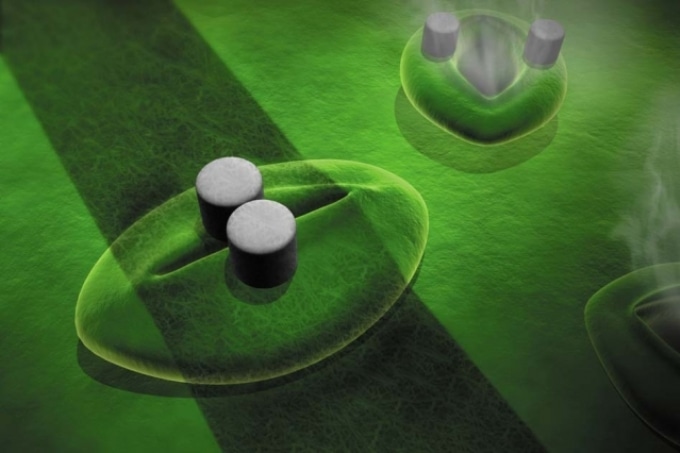Nov 9 2017
Engineers at Massachusetts Institute of Technology (MIT) have developed novel sensors that can be printed onto the leaves of plants and reveal when the plants experience a water shortage.
 Artist's impression of the sensor comprised of conductive ink printed across a stoma with two micropillars. (Image: Betsy Skrip)
Artist's impression of the sensor comprised of conductive ink printed across a stoma with two micropillars. (Image: Betsy Skrip)
According to Michael Strano, the Carbon P. Dubbs Professor of Chemical Engineering at MIT and the study’s senior author, this kind of technology could save neglected houseplants and more importantly, send an early warning to farmers when their crops are in danger.
This appears to be the earliest indicator of drought that we have for agricultural applications. It’s hard to get this information any other way. You can put sensors into the soil, or you can do satellite imaging and mapping, but you never really know what a particular plant is detecting as the water potential.
Michael Strano, The Carbon P. Dubbs Professor of Chemical Engineering, MIT
Strano is aiming to develop these sensors that can be used on crops, and for this he has already started working with a major agricultural producer. According to him, the technology could also prove useful to urban farmers as well as gardeners. It could also aid scientists to develop new methods for designing drought-resistant plants.
MIT postdoc Volodymyr Koman is the lead author of the paper, which was published in the online edition of the journal, Lab on a Chip.
Printable Sensors
Dry soil tends to slow down plants’ growth, reducing their photosynthetic activity and causing damage to their tissues. While some plants start to wilt, others show no perceptible signs of trouble until they have already suffered considerable damage.
The new sensor developed by MIT engineers leverages the plants’ stomata, which are tiny pores present in a leaf’s surface and enable water evaporation. As water evaporates from the surface of the leaf, water pressure in the plant reduces, enabling it to draw up the water from the soil via a process known as transpiration.
Plant biologists are aware that stomata close in darkness and open when exposed to light; however, little research has been made on the dynamics of this closing and opening because no accurate way was available to directly measure the stomata in real time.
People already knew that stomata respond to light, to carbon dioxide concentration, to drought, but now we have been able to monitor it continuously. Previous methods were unable to produce this kind of information.
Volodymyr Koman, Postdoc, MIT
In order to develop the sensor, the MIT team employed an ink made of carbon nanotubes, which are minute carbon hollow tubes that conduct electricity. They then dissolved this ink in sodium dodecyl sulfate, an organic compound that does not affect the plants’ stomata. An electronic circuit can be produced by printing this ink across a pore. The circuit remains intact even when the pore is closed and it can be connected to a device known as multimeter to measure the current. However, when the pore is opened, the circuit breaks down, which stops the current flow, enabling the research team to measure accurately when a single pore is closed or opened.
By measuring the dynamics of this closing and opening over a few days, within dry and normal conditions, the MIT researchers discovered that they can detect when a plant is experiencing water shortage in just two days. They also discovered that it takes stomata approximately seven minutes to open following exposure to light, and 53 minutes to close after darkness. However, during dry conditions, these responses change. When there is a water shortage, the team observed that the plants’ stomata take an average time of 25 minutes to open, but only 45 minutes to close.
This work is exciting because it opens up the possibility of directly printing electronics onto plant life for long-term monitoring of plant physiological responses to environmental factors, such as drought.
Michael McAlpine, Associate Professor, Mechanical Engineering, The University of Minnesota
Drought Alert
For their work, the MIT researchers tested their sensors on a plant known as the peace lily, which they selected in part due to its large stomata. Before applying the ink to the leaves, they first developed a printing mold with a microfluidic channel. Once the printing mold is placed on a leaf, the ink which is flowing through the channel gets deposited onto the surface of the leaf.
The researchers are now exploring a new method to use the electronic circuits by merely placing a sticker on the surface of the leaf. According to them, urban farmers and gardeners may also be interested in such a device, apart from large-scale agricultural producers.
“It could have big implications for farming, especially with climate change, where you will have water shortages and changes in environmental temperatures,” Koman says.
In a similar work, Strano’s lab is studying the possibility of developing a range of these sensors that could be applied to identify light and capture images, just like a camera.
The U.S. Department of Energy, the Swiss National Science Foundation, and Singapore’s Agency for Science, Research, and Technology funded the study.